Published on Monday, 20 April 2020 at 10:02:52 AM
WW1 - Private George James FEATONBY
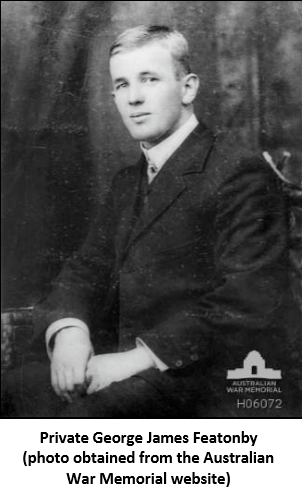
Service Number: 2368 Unit: 11th Battalion, Australian Infantry, A.I.F.
Private George James Featonby enlisted in Narrogin on 28th May 1915 at the age of 35. He embarked from Fremantle on the HMAT Karoola on 25th June 1915 as part of the 7th Reinforcements of the 11th Infantry Battalion. He was killed in action at Gallipoli on 6th August 1915 and is buried at the Shell Green Cemetery, Turkey.
George Featonby had been farming at Dorakin for about four years when he enlisted for World War 1. He was the second son of Theker and Annie Featonby of Auburn, Victoria. His brother was a Captain in the Australian Medical Corps in England. George played cricket for Dorakin in 1913. An article about him in “The Bendigonian” states: “George Featonby was one of the bright boys of the Bendigo Grammar School, matriculating at 14, and winning the position of dux in 1894. He went to Queen’s College, Melbourne University, and studied law for two years, but was obliged to retire on account of eye strain. In 1904 he went to Europe and travelled all over the continent. Two years later, after holding a responsible position and passing through many exciting adventures on the pearling station at Broome, he again visited England with his mother and sisters. On his return, he settled on the land in the wheat growing district of Western Australia, and was doing very well indeed when the call to arms came.”
George Featonby sailed from Egypt on 1st August 1915, arriving at the Dardanelles to join his battalion on 4th August 1915. He died at Lone Pine, Gallipoli, only two days later on 6th August 1915. George Featonby was buried at the Shell Green Cemetery, Plot 2, Row 1, Grave 2.
Private George James Featonby was 36 years of age when he died. He is honoured on the Wickepin War Memorial. Private George James Featonby's name is located at Panel 62 in the Commemorative Area at the Australian War Memorial.
Sergeant Thomas Leonard JOHNSON – Military Medal

Service Number: WX1024 Unit: 2/11th Battalion, Australian Infantry, A.I.F.
Thomas Leonard Johnson was born on 19th October 1913 in Wickepin, the fourth child of Frederick Charles (Fred) and Mabel Johnson. He had five brothers, Frederick Charles (Charlie), Richard John, William Robert (Bob), Irven McInnes and James Alexander, and five sisters, Hilda Margaret, Marjorie Mabel, Mary Agnes, Winifred Augusta and Kathleen Rose. The family farm “Plainview” was east of Wickepin, near the 86 Gate, and Tom and his brothers helped to run it. Four of his brothers, Charlie, Bob, Irven and Richard, also served in World War 2 and Tom’s uncle Irven McInnes was killed in World War 1.
Tom Johnson’s service record has not yet been digitised on the National Archives website, therefore only limited information was available for his war service. He enlisted in Subiaco on 23rd November 1939 and was part of the 2/11th Infantry Battalion. The history of the 2/11th Infantry Battalion on the Australian War Memorial website reveals their details: “The 2/11th Infantry Battalion was the first Western Australian battalion raised for service overseas during World War 2. Its formation began with the appointment of its first commanding officer on 13th October 1939 and by 7th November it was assembling at the newly built Northam Camp to begin training. On 30th November it left Northam to join the 18th Brigade of the 6th Australian Division, a journey that would end at another new camp at Greta in New South Wales. The battalion returned to Western Australia in the middle of March and embarked at Fremantle for service overseas on 20th April 1940.
After arriving in the Middle East on 18th May, the 2/11th Infantry Battalion trained in Palestine and Egypt. A decision to re-organise Australian infantry brigades along British lines, with three battalions instead of four, meant the 2/11th Infantry Battalion was now part of the 19th Brigade, but it remained part of the 6th Division. The battalion went into action for the first time at Bardia on 5th January 1941 and, as part of the Allied advance into Italian occupied Libya, subsequently fought at Tobruk on 21st and 22nd January, and to secure Derna airfield on 25th January. It was advancing to the south of Benghazi when the Italians surrendered on 7th February.” In April 1941 Tom Johnson was awarded the Military Medal for his “bravery and leadership near Derna on 27th January 1941”. In a letter to his sister published in the “Western Mail” on 17th April 1941 he described the events which led to his award:
“We’ve been through three scraps now and during the second one we lost our platoon Sergeant and being senior Corporal I had to take his place. In the last scrap our platoon commander was knocked out so being Acting Sergeant, I had to take charge of the platoon. Things were pretty hot for the time and during the three days I was in charge things weren’t the best. I was darned glad when they sent an officer along to take charge. In recognition of good service while in action, I collected my third stripe. The first couple of days when someone hollered out “Sergeant Johnson” I looked around to see who the newcomer was. However, I am used to it now. We are still on the move and are likely to be for some time yet. The boys are getting case hardened to dust, sand and the general discomforts of the life of a soldier. The thirteen stone I was telling you about has gone by the board and has dwindled to about eleven stone seven. Although now I’m gaining it again as the living is fairly good, with an occasional chicken or two bought off the Arabs with good Italian money, picked up on our travels.” Further sections of the letter were published in the “Daily News” on 4th April 1941: “After Derna we carried on and went through Benghazi only to find that the armoured division had cleaned up the remnants of the Italian army. We came back along the coast for a fairway and stayed billets in an old port for about a fortnight. During our stay there Mr. Menzies gave us an address, patted us on the back for the work we had done, and generally blew down our ears. Since then we have shifted around a bit and now are parked out in the desert once again.” The next movements of the 2/11th Infantry Battalion are described in their history on the Australian War Memorial website: “In early April 1941 the 2/11th Infantry Battalion were deployed to assist in the defence of Greece. The Allied forces, however, were unable to hold back the attacking Germans. The 2/11th Infantry Battalion withdrew from its initial positions at Kalabaka and remained on the move until it occupied rearguard positions at Brallos Pass a week later. It fought and slowed the Germans there on 24th April and then continued its withdrawal to Megara, where it was evacuated by sea on the night of 25th April. The battalion landed on Crete the next day. It was subsequently deployed with the 2/1st Infantry Battalion to defend Retimo airfield, which was held tenaciously for ten days following the landing of German paratroops on 20th May. German successes elsewhere on Crete, however, made surrender inevitable. Many soldiers of the 2/11th Infantry Battalion attempted to escape from Crete but only a relatively small number ultimately succeeded; most were taken, prisoner.
Tom was among the men taken prisoner of war, as his name appeared in an International Red Cross list of wounded and sick men in Kokkinia Prisoner of War Hospital, Greece. Although no further records are available, it can be assumed that Tom remained a prisoner of war until the end of World War 2. He was discharged from the Australian army on 17th March 1949. The next chapter in Tom’ life was described in a newspaper article from the late 1960s about a 2/11th Infantry Battalion reunion in Bunbury: “Tom took his discharge from the A.I.F. in Tokyo, Japan, afterwards enlisting with the United States Army. He fought in Korea and returned to America to go to Germany with the occupation forces for three years. He became a Master Sergeant Instructor. In 1962 he was sent to Vietnam as an adviser to the South Vietnamese Army, returning to the US to lecture as an instructor for the reserve officers’ training college. He returned on combat duty to Vietnam and after 14 months took special leave to Western Australia, visiting relations and friends in Bunbury and Perth. He is married to an American girl and has a daughter married to a US Army Lieutenant stationed in Germany. He returns to Vietnam shortly for a further four months of combat duty before returning to the States.”
WW1 - Trooper William John McCALL
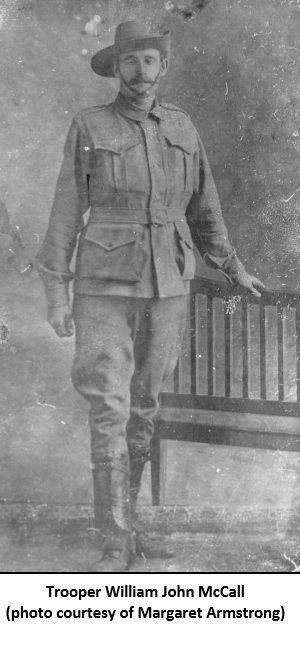
Service Number: 453 Unit: 10th Light Horse Regiment, A.I.F.
Trooper William John McCall enlisted in Guildford on 6th October 1914 at the age of 22. He embarked from Fremantle on the HMAT Surada on 17th February 1915 as part of the original 10th Light Horse Regiment. He was killed in action at Gallipoli on 29th August 1915 and is commemorated on the Lone Pine Memorial, Gallipoli, Turkey.
Bill McCall was working as a labourer in Wickepin when he enlisted for World War 1. He was the second son of John Gibb and Mary McCall of Colac, Victoria. Willie and his brother, Norman, had moved from Victoria to Western Australia in 1913 to visit their uncle and aunt, Archibald and Alice McCall, at Wickepin. They had planned to stay for a while and work, but the outbreak of war changed their plans. Bill was the first member of the extended family to enlist and his mother made a hurried sea journey to the West to farewell her son. She was to endure the disappointment of arriving too late and never saw him again. Bill was one of 11 members of the extended McCall family in Western Australia and Victoria to enlist. Also honoured on the Wickepin War Memorial are Bill’s older brother, Norman, who also served with the 10th Light Horse Regiment, and five of his cousins, brothers Archibald Robert and Daniel James McCall, who both returned and three Facey brothers, Joseph Thomas (page 44), Roy Barker (page 46) and Albert Barnett, of which the first two also lost their lives at Gallipoli.
Bill McCall had already served six months with the 60th Light Horse in Victoria before enlisting for World War 1. He trained at Blackboy Hill Camp before sailing for Egypt in February 1915. His embarkation record shows his last name as McColl. Bill joined his regiment at Gallipoli in May 1915, and was reported missing on 29th August 1915. A court of enquiry declared in December 1916 that he had been killed in action on Walkers Ridge, Gallipoli. Bill McCall was most likely never buried and is remembered on the Lone Pine Memorial, Panel 10.
Trooper William John McCall was 23 years of age when he died. He is honoured on the Wickepin War Memorial. Trooper William John McCall's name is located at Panel 8 in the Commemorative Area at the Australian War Memorial.
WW2 - Flight Sergeant Claude Bertram SIMPSON
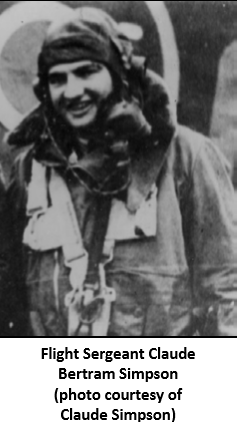
Service Number: 427954 Unit: No. 463 Squadron, R.A.A.F.
Flight Sergeant Claude Bertram Simpson enlisted at the No. 4 Recruiting Centre in Perth on 11th October 1942 at the age of 18. He was killed in action over Duisburg, Germany, on 22nd May 1944 and is commemorated on the Runnymede Memorial, Surrey, England.
Claude Simpson was born on 24th January 1924 in Wickepin. He was the second son of Claude Downie and Elizabeth Herbertson Simpson and his siblings were Andrew Downie (Drew), Ian, Winnifred, Fiona and Cynthia. Claude was homeschooled until he attended Guildford Grammar School from 1938 to 1940. During his last year at school, when only 16 years of age, Claude ran away from school to enlist in the A.I.F. The reason for his absence was a rumour, started by Claude himself, that he was in bed with Mumps, which was very prevalent in those days. He was physically well built and had no trouble convincing the recruiting officer that he was 21 years old. Unfortunately for Claude, his brother Drew, who was also enlisting in the A.I.F. found out and told their father, who was training the new recruits. Claude was promptly sent back to school, where he graduated in November 1940 with a Junior Certificate. He started work as a radio announcer with 6IX Perth but was still determined to play his part in the war. In March 1942 he enrolled in the reserve of the R.A.A.F., before enlisting for overseas service in October of the same year. Claude’s older brother, Drew Simpson, also served in World War 2 with the 2/11th Infantry Battalion and returned to Australia in January 1946. Their father, Claude Downie Simpson, had served as a signaller with the 11th Infantry Battalion in World War 1 and also served in World War 2 at Head Quarters Western Command in Perth.
After enlisting with the R.A.A.F. Claude was sent to the No. 5 Initial Training School at Clontarf before attending the No. 1 Wireless Air Gunners School in Ballarat, Victoria, in April 1943. After receiving his gunners badge, he embarked from Melbourne on 3rd July 1943 and arrived in England in August that year. His conduct sheet reveals that he was absent from the base at Litchfield for five days in September, for which he was reprimanded and forfeited six days of pay. Claude served as a rear gunner with the 463 Squadron, R.A.A.F, flying in Lancaster Bombers over Europe. The crew included seven men and they flew 16 air operations from March to May 1944, mainly over French and German territory. During their 16th air operation they were detailed to attack Duisburg, Germany, leaving the R.A.F. base in Waddington, England, during the night of 21st and 22nd May 1944 along with 14 other aircraft. Two of them, including the one Claude Simpson was in, failed to return to base, presumably due to enemy action, and were officially declared missing on 1st June 1944. Subsequent inquiries found no trace of the missing aircraft or crew members and on 7th March 1945 the military authorities sent a letter to Claude’s parents stating that due to the fact he has been missing for such a long time “it is feared that all hope of finding him alive must be abandoned.” To enable them to declare Claude “presumed dead” they asked the parents to provide a statement “that you have received no further news of your son since the date when he became missing, if such is the case.” Understandably, Claude’s parents did not want to give up on the search for their missing son and his father sent a reply letter, outlining his objections.
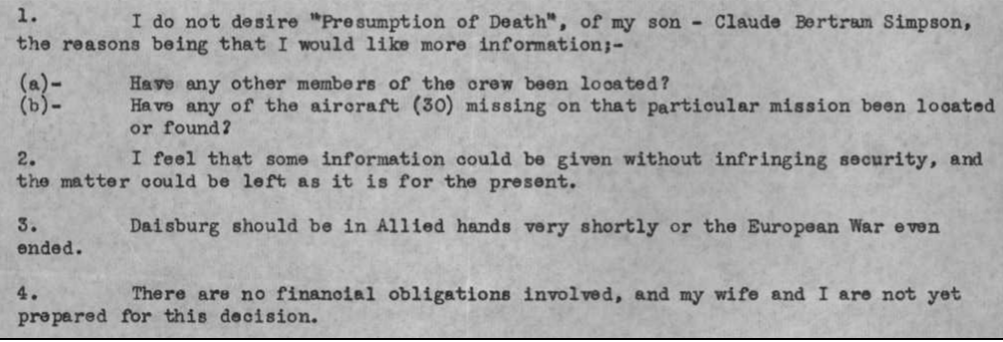
The authorities sympathised with the parents, but explained that these are departmental procedures which needed to be followed. Claude Bertram Simpson was officially declared “presumed dead” on 15th June 1945. Post war searches found no trace of the missing aircraft or crew and they were declared as having been killed in action over Duisburg, Germany, on 22nd May 1944. Claude Simpson is remembered on the Runnymede Memorial, Panel 261.
Flight Sergeant Claude Bertram Simpson was 20 years of age when he died. He is honoured on the Wickepin War Memorial. Flight Sergeant Claude Bertram Simpson's name is located at Panel 109 in the Commemorative Area at the Australian War Memorial.
WW1 - 2nd Lieutenant Joseph Henry COOKE

Unit: 11th Battalion, Australian Infantry, A.I.F. 2nd Lieutenant
Joseph Henry Cooke enlisted in Wagin on 15th August 1914 at the age of 31. He embarked from Fremantle on the HMAT Ascanius on 2nd November 1914 with the original 11th Infantry Battalion. He was killed in action at Gallipoli on 25th April 1915 and is commemorated on the Lone Pine Memorial, Gallipoli, Turkey.
Joseph Cooke worked as an accountant in Wickepin when he enlisted for World War 1. Born in Dinapore, India, on 26th October 1882, he was the son of Alfred Edward and Elizabeth Catherine Cooke. At the age of 16 he enlisted as a drummer boy with his father’s regiment, the 1st Battalion Lancashire Fusiliers, and later served as a Sergeant and Colour Sergeant for a total of 12 years. Joseph came to Australia at the age of 29 as part of a soldier settlement scheme by the British government. He was married to Rosetta Agnes Boon Cooke and they built the brick house at 48 Dumbleyung Road, Wickepin, in 1911. Joseph and Rosetta assisted with the establishment of the Anglican Church in Wickepin and a memorial cross. The collection plate is in their name. At his death Joseph left behind his wife, one son, Mervyn and two daughters, Alys and Kathleen. Mervyn Cooke was selected to assist at the official unveiling of the Wickepin District Honour Roll of World War 1 in April 1918.
Joseph Cooke enlisted as Private and was initially given the service number 883. However, he was quickly promoted to Sergeant on 1st September 1914 and to 2nd Lieutenant on 27th October 1914, before embarking from Australia with the first convoy. He left Alexandria in March 1915 and sailed to the Dardanelles. Joseph was involved in the landing at Gallipoli on 25th April 1915, but did not return. On 2nd May 1915, he was declared missing in action and inquiries into his death began. A court of inquiry in April 1916 confirmed that he had been killed in action and the date of his death was declared to be 2nd May 1915. This is still his official date of death, however, compelling evidence points to Joseph’s date of death as 25th April 1915. A witness account from a Private Pickles described Joseph’s death on the first day of the Gallipoli landings: “Mr Cooke was hit about five o’clock on the afternoon of April 25th. The third Brigade was holding the second ridge at the time and witness was about fifty yards away at the time. Seeing Mr. Cooke fall, witness went up to him and found that he had been shot through the chest. Witness and another man remained with Mr. Cooke until his death which was in about half an hour. He was conscious, did not seem to be suffering but said very little indeed. Shortly after his death, there was a retirement so his body had to be left.” Another indicator that his death occurred on the first day of the Gallipoli landings is an article in the “Wickepin Argus” on 22nd July 1915, where an extract from a letter written by a soldier named Frank Marshall to the postmaster at Wickepin, Mr. Gorman, was published: “Have you heard of a Mr J. H. Cooke from Wickepin. He was my Platoon Commander, and a Lieutenant. He was one of the whitest men I ever met, and although only about 30 years old, a glorious leader. He led us in all our charges and was always first all through the terrible times we had the first day and showed great bravery. When all were ordered to fall back on our main position on the first night we were cut to pieces. Mr Cooke did not come back and we have not heard of him since, so he must have been killed. We all loved him, and any of us would give anything to see him again, but will never see him again. If you see anyone who knows him, tell them how brave he was.” An article about Joseph Cooke, sent in by his descendants and printed in the “The West Australian” on 22nd October 2014 explains that the family also believe he was killed on the first day of the Gallipoli landings: “Cooke had been killed more than two weeks earlier on the first day of the landing at Gallipoli. Later, perhaps understandably because of the mayhem and confusion of 25th April, some records listed his death as 2nd May.” Joseph Cooke has no known grave and is remembered on the Lone Pine Memorial, Gallipoli, Panel 33.
2nd Lieutenant Joseph Henry Cooke was 32 years of age when he died. He is honoured on the Wickepin War Memorial. Second Lieutenant Joseph Henry Cooke's name is located at Panel 61 in the Commemorative Area at the Australian War Memorial.
WW2 - Sister Minnie Ivy HODGSON
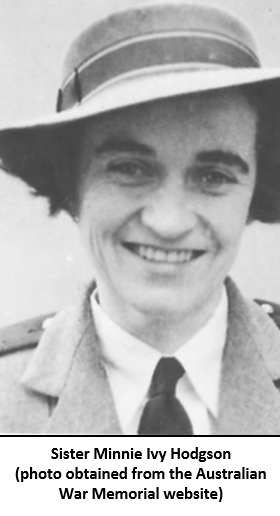
Service Number: W16357 (later WX11174, then WFX11174) Unit: 2/13th Australian General Hospital, Australian Army Nursing Service, 2nd A.I.F.
Sister Minnie Ivy Hodgson enlisted at Swan Barracks, Perth, on 14th July 1941 at the age of 32. She was executed whilst a prisoner of war on Radji Beach, Banka Island, Indonesia, on 16th February 1942 and is commemorated on the Singapore Memorial, Kranji War Cemetery, Singapore.
Minnie Hodgson was born on 16th August 1908 in Perth, the daughter of John William and Contrary (Connie) Hodgson, and had five surviving brothers, Harry, Bill, Jim, Oliver and Dick, and one sister, Fanny. In 1908 John Hodgson set out for Yealering and selected a block of land. Connie and the children joined him a few years later, once the family farm “Windstorm” was established. Minnie and her siblings attended primary school at Yealering and she then went to Perth to finish her schooling at Methodist Ladies College. Minnie trained as a nurse at the Children’s Hospital (later Princess Margaret Hospital) and later nursed at King Edward Memorial Hospital. Prior to her enlistment, Minnie was matron at the Kondinin Hospital. Minnie’s brothers William James (Bill), James Alfred George (Jim) and Richard Herbert (Dick) all served in World War 2.
Minnie Hodgson originally enlisted in the Nursing Service on 12th December 1940 and was given service number W16357. She worked at hospitals in Northam and Narembeen before being seconded to the A.I.F. in August 1941. She was given a new service number (WX11174) and allocated to the 2/13th Australian General Hospital. She embarked on the hospital ship “Wanganella” on 8th September 1941 bound for Singapore. In October Minnie spent two days in the hospital as a patient, suffering from Influenza. She was transferred several times between the 2/13th and 2/10th Australian General Hospitals, which were both stationed on the Malayan mainland. On 8th December 1941, the Japanese launched their invasion of Malaya and their rapid advance soon forced the 2/10th Australian General Hospital to withdraw to Singapore. Minnie returned to her own unit, the 2/13th General Hospital, which remained as the only Australian hospital in Malaya.
The article on the 2/13th Australian General Hospital on the Australian War Memorial website states: “They treated most of the casualties that resulted from battles in Johore and, as the fighting got closer, it effectively became a large-scale casualty clearing station - the most forward surgical unit in the army’s medical organisation. On 23rd January, the approach of the Japanese also forced the 2/13th Australian General Hospital to withdraw to Singapore. Like all medical units, the 2/13th Australian General Hospital was hard-pressed during the fighting for Singapore. It was subject to bombing, sustaining hits to both its kitchen and a ward, and had to operate under complete blackout conditions at night. Mounting casualties soon outstripped the hospital’s ability to accommodate and treat them and patients had to lie on the lawns around the hospital. With defeat appearing imminent the nursing sisters were progressively evacuated on three ships.” The last contingent of 27 left for Australia aboard the ill-fated SS Vyner Brooke on 12th February 1942, Minnie Hodgson being among them. The nurses were reluctant to leave, as the hospital was full of wounded soldiers and they did not believe they had a chance of safely getting away from Singapore.
The article on the Australian War Memorial website about the sinking of the Vyner Brooke states what happened next: “On the evening of 12th February 1942 Vyner Brooke was one of the last ships carrying evacuees to leave Singapore. Although she usually only carried 12 passengers, in addition to her 47 crew, Vyner Brooke sailed south with 181 passengers embarked, most of them women and children. Among the passengers were the last 65 Australian nurses in Singapore. Throughout the daylight hours of 13th February Vyner Brooke laid up in the lee of a small jungle-covered island, but she was attacked late in the afternoon by a Japanese aircraft, fortunately with no serious casualties. At sunset she made a run for the Banka Strait, heading for Palembang in Sumatra. Prowling Japanese warships impeded her progress and daylight on 14th February found her dangerously exposed on a flat sea just inside the strait. Not long after 2pm Vyner Brooke was attacked by several Japanese aircraft. Despite evasive action, she was crippled by several bombs and within half an hour rolled over and sunk bow first. Approximately 150 survivors eventually made it ashore at Banka Island, after periods of between eight and 65 hours in the water. The island had already been occupied by the Japanese and most of the survivors were taken captive. However, an awful fate awaited many of those that landed on Radji beach.
The survivors from the Vyner Brooke joined up with another party of civilians and up to 60 Commonwealth servicemen and merchant sailors, who had made it ashore after their own vessels were sunk. After an unsuccessful effort to gain food and assistance from local villagers, a deputation was sent to contact the Japanese, with the aim of having the group taken prisoner. A party of Japanese troops arrived at Radji Beach a few hours later. They shot and bayoneted the males and then forced the 22 Australian nurses and one British civilian woman who had remained to wade into the sea, then shot them from behind. There were only two survivors - Sister Vivian Bullwinkel and Private Cecil Kinsley, a British soldier. After hiding in the jungle for several days the pair eventually gave themselves up to the Japanese. Kinsley died a few days later from his wounds, and Bullwinkel spent the rest of the war as an internee.
Of the 65 Australian nurses embarked upon the Vyner Brooke, 12 were killed during the air attack or drowned following the sinking, 21 were murdered on Radji Beach and 32 became internees, 8 of whom subsequently died before the end of the war.” Sister Vivian Bullwinkel was only able to tell the story of what happened on Radji Beach after her release from Japanese internment. Minnie Hodgson was reported missing in April 1942 and it was not until December 1945 that she was declared “deceased whilst POW, executed by Japanese on 16th Feb 1942”. Minnie Hodgson has no known grave and is commemorated on the Singapore Memorial, Column 141.
Sister Minnie Ivy Hodgson was 33 years of age when she died. She is honoured on the Wickepin War Memorial, the Yealering Memorial Gates and the Corrigin Honour Roll. There is a plaque on May Drive in Kings Park, Perth, dedicated by her niece and she is also remembered on the Vyner Brooke Memorial at Point Walter Reserve, Bicton. Sister Minnie Ivy Hodgson’s name is located at Panel 96 in the Commemorative Area at the Australian War Memorial
WW1 - Private John Thomas MESSENGER
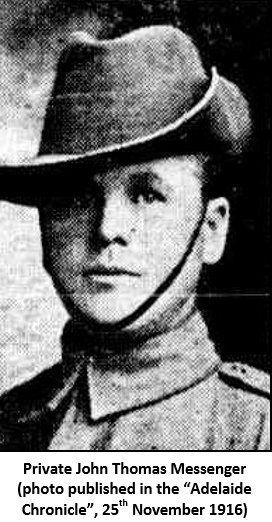
Service Number: 1756 Unit: 28th Battalion, Australian Infantry, A.I.F. Private
John Thomas Messenger enlisted in Wickepin on 3rd June 1915 at the age of 27. He embarked from Fremantle on the HMAT Demosthenes on 23rd July 1915 as part of the 2nd Reinforcements of the 28th Infantry Battalion. He was killed in action in Pozieres on 6th August 1916 and is commemorated on the Villers-Bretonneux Memorial, France.
Tom Messenger was a railway porter at the Wickepin Railway Station before he enlisted for World War 1. Born on 6th August 1887 in Barby, England, he was the younger son of Thomas and Abigail Messenger. He gave his address upon enlistment as “care of Miss Mena Houston, Wickepin”, who was the school teacher at the Inkiepinkie School at that time. The “Adelaide Chronicle” writes on Fallen but not Forgotten Private John Thomas Messenger (photo published in the “Adelaide Chronicle”, 25th November 1916) Letter from John Thomas Messenger to his parents before he embarked for overseas service - unfortunately, the whereabouts of the photo referred to in this letter are unknown - (photo obtained from the service record of Private John Thomas Messenger on the National Archives website)
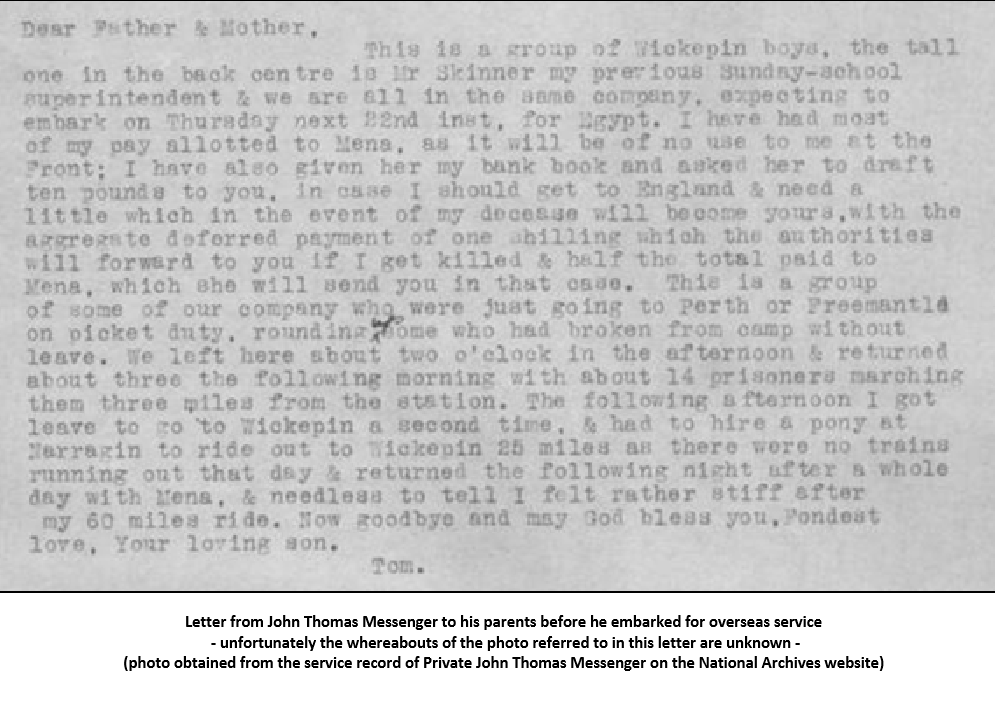
25th November 1916: “Private John T. Messenger, who gave his life at Pozieres on August 6, was the son of Mr. and Mrs. T. Messenger, of Barby, Rugby, England. Private Messenger arrived in Western Australia in January 1914, and settled in Wickepin, where he was highly esteemed. He was an active member of the Church of England and was a Sunday-school teacher and organist. His sincere and honourable disposition left a lasting impression on the young folk. He enlisted in June 1915, considering that it was his duty to go and do what he could to help his comrades at the front. After serving some months in the trenches in Gallipoli he proceeded to France, where he fell trying to save a wounded comrade. He was an esteemed friend of Miss Mena Houston, school teacher, of Wickepin, Western Australia, and of Sergeant Hugh Houston, on active service, France.”
Tom Messenger first went to Gallipoli in October 1915 where he served some months in the trenches before returning to Egypt in January 1916. The battalion was then sent to France in March 1916 where he fell trying to save a wounded comrade. He was killed in action on 6th August 1916, on his 29th birthday. Tom Messenger has no known grave and is remembered on the Villers-Bretonneux Memorial.
Private John Thomas Messenger was 29 years of age when he died. He is honoured on the Wickepin War Memorial. Private John Thomas Messenger's name is located at Panel 114 in the Commemorative Area at the Australian War Memorial.
WW2 - Lance Corporal William Francis HEALEY
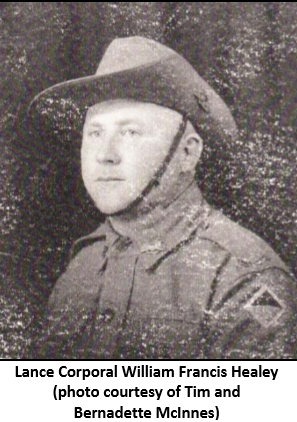
Service Number: WX5615 Unit: 2/16th Battalion, Australian Infantry, 2nd A.I.F.
Lance Corporal William Francis Healey enlisted in Narrogin on 29th May 1940 at the age of 25. He was killed in action in Gona, Papua New Guinea, on 8th December 1942 and is buried at the Port Moresby (Bomana) War Cemetery, Papua New Guinea.
Frank Healey was born in Wickepin on 23rd July 1914, the son of William and Margaret Healey, and had three brothers, Patrick, Michael and Richard, and four sisters, Robina, Evelyn, Mary (Mollie) and Mabel. Frank attended the Elsinore school and farmed with his family at Dudinin. He had just bought his own parcel of land and called it “Frankville” when he enlisted for World War 2. The Ledwith family farm the land today and it is still called “Frankville”. Frank was much loved around the district and over 60 family and friends gathered at the Healey family home to celebrate Frank’s 21st birthday in 1935.
A condolence letter sent by Jack and Myrtle Spark to Frank’s parents in January 1943 also speaks highly of him: “This is about the hardest task I have been called upon to do for many a day, to say “you all have our very deepest sympathy in your recent bereavement” words are rather futile in matters such as this, but we want you all to know we are all sharing your great sorrow. It doesn’t seem real that big, laughing, friendly Frank has been called upon to make the supreme sacrifice but as he lived I guess he died. We must just make ourselves keep his picture in our memories as we last saw him in his gayest mood and our hands and hearts still tingle with that last warm handclasp and smile. Dear friends, you will know now you have big-hearted friends who will help you to bear your burden always and be proud of your great son with you and forever hold his memories dear.”
In July 2011 Frank’s great-niece Bernadette and her husband Tim McInnes travelled to Papua New Guinea to walk the Kokoda trail, carrying Frank’s medals with them. They visited the Port Moresby (Bomana) War Cemetery and scattered some soil from Frank’s farm over his grave and buried a photo of his sister, Robina, in the soil beneath Frank’s headstone. Five of Frank’s cousins, Frederick Charles, Irven McInnes, Richard John, William Robert and Thomas Leonard Johnson (page 222), served in World War 2. Frank’s uncles, Maurice Healey and Irven McInnes, served in World War 1 with the latter losing his life in France.
After enlisting in Narrogin, Frank Healey was sent to Northam Camp, where he was assigned to the 2/16th Infantry Battalion and commenced his basic training. In September 1940 he was granted one week of leave and he wrote to his sister Robina: “You had better kill off some of those turkeys when I come up as I am looking forward to a good feed.” Frank embarked from Fremantle on 25th October 1940 for the Middle East. After arrival, the battalion moved straight to Palestine to complete its training. In January 1941 Frank spent ten days in the hospital with Mumps. The history of the 2/16th Fallen but not Forgotten Battalion on the Australian War Memorial website details their engagement in the Middle East: “The 2/16th Battalion’s first operational assignment of war was to bolster the defences along the Egypt-Libya frontier against an expected German attack. It occupied positions at Maaten Bagush and Mersa Matruh throughout much of April and May 1941, before returning to Palestine in preparation for its first offensive operation, the invasion of Syria and Lebanon.
The campaign, beginning on 8th June 1941, was characterised by difficult and costly actions against wellentrenched Vichy French troops and the 2/16th Battalion suffered the most casualties (264) of any of the Australian battalions involved. Its major battles were the crossing of the Litani River on 9th June, the unsuccessful attempt to capture Sidon on 13th June, and the seizure of El Atiqa Ridge, as part of the battle of Damour, on 6th July. The 2/16th Battalion remained in Lebanon after the armistice of 12th July as part of the Allied garrison force.”
On 23rd August 1941 Frank wrote to his sister Robina: “I have been off colour lately with a touch of sand fly flu fever, not very serious though, and I am now up in the mountains having a rest. I am told the part where I am is about 4,500ft above sea level, so the air is very clear and nippy, which is a long way better that what it is on the coast, and no mosquito’s here, which is another good.” In September 1941 Frank was admitted to hospital for two weeks with Tonsillitis.
The 2/16th Infantry Battalion left the Middle East in January 1942 and disembarked in Adelaide on 25th March 1942. In May 1942 Frank Healey was graded a Group 3 Driver Mechanic and appointed Lance Corporal. In August the battalion embarked from Brisbane with Port Moresby, Papua New Guinea, as their destination. The battalion was in action against the Japanese, almost immediately, with relentless fighting along the Kokoda Trail, resulting in heavy casualties. The 2/16th Battalion, as part of the 21st Brigade of the 7th Division, were given the task of halting the Japanese advance and to push them back to the sea where they landed. It is estimated that there were up to 20,000 Japanese soldiers, at no time during the advance did the odds in Japans favour fall to less than four in one. For weeks the Australians were driven back towards Port Moresby, the jungle unforgiving, lashed by heavy, bitterly cold rain, their eyes blinded by the wind, their enemy relentless.
By the end of September they had dug in at Imita Ridge, but the sight and sounds of hundreds of carriers and packed horses and mules bringing food, ammunition and reinforcements revived the soldiers’ spirits. The Japanese finally retreated and the Australians pushed them all the way back to the sea. The history of the 2/16th Battalion on the Australian War Memorial website reveals their next engagement: “After a short rest the 2/16th Battalion joined the operations at Gona on 26th November 1942. Consisting of only two companies when it entered the fighting, the 2/16th Infantry Battalion left Gona on 7th January 1943 only 56 strong.” The war diaries of the 2/16th Battalion state that it rained for hours on the morning of 7th January, all trenches were filled with water and everyone was soaked through. On 8th December the Japanese were observed wearing respirators and moving about with fixed bayonets and the possibility of a gas attack was feared. The Australian attack began at 11am with Australian mortars and field guns firing an intense barrage with deadly effect. The battalions fought on all afternoon and into the night and in this battle Frank Healey was killed in action. The next day was spent burying, salvaging and cleaning up the area. The village of Gona was in shambles with Japanese and Australian dead everywhere. Frank Healey was among the men buried at Gona Mission Cemetery. On 23rd August 1943 he was reburied in the Gona War Cemetery, and on 8th June 1944 he was re-buried again. Frank Healey now rests in Port Moresby (Bomana) War Cemetery, Section C, Plot 5, Row F, Grave 20.
Lance Corporal William Francis Healey was 28 years of age when he died. He is honoured on the Wickepin War Memorial and the Dudinin Honour Roll. There is a plaque on Lovekin Drive in Kings Park, Perth, dedicated by his family. Lance Corporal William Francis Healey’s name is located at Panel 39 in the Commemorative Area at the Australian War Memorial.
WW1 - Lieutenant Thomas Balfour KEILLOR, Military Cross. and Bar
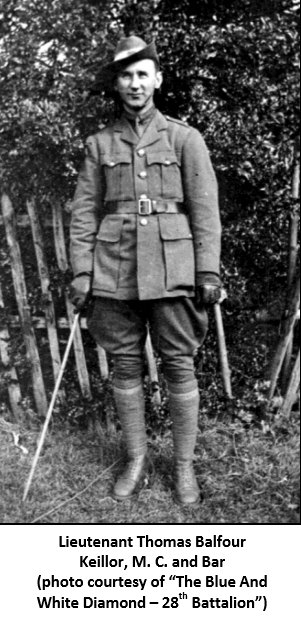
Service Number: 4464 Unit: 28th Battalion, Australian Infantry, A.I.F.
Lieutenant Thomas Balfour Keillor, M. C. and Bar enlisted in Wickepin on 18th February 1916 at the age of 26. He embarked from Fremantle on the HMAT Shropshire on 31st March 1916 as part of the 11th Reinforcements of the 28th Infantry Battalion. He was killed in action near Beaurevoir on 3rd October 1918 and is buried at the Hargicourt British Cemetery, France.
Tom Keillor was working as a grocer’s assistant for Mr. F. H. Button in Wickepin before he enlisted for World War 1. Born in Arbroath, Scotland, he was the fourth son of Alexander M. and Jessie Davidson Keillor. He was working as a grocery salesman in his hometown of Arbroath before coming to Australia at the age of 21. Tom was a keen golfer and elected as the honorary secretary and treasurer of the Wickepin Golf Club at their annual meeting on 19th March 1915. He can lay claim to scoring the first ever hole-in-one on the Wickepin Golf Course. Besides golf he was also an active member of the Wickepin Cricket Club in 1911 and 1912. An article in the “Pingelly Leader” on 18th February 1916 tells of a farewell party held for him: “On Monday evening last the Yarling Hall was crowded, the occasion being to say au revoir to Mr. Tom B. Keillor, who is leaving to take his place in the firing line. During the evening dancing was indulged in, together with songs from the leading singers of Wickepin. Mr. E. B. Johnson, M.L.A., in a few appropriate words, presented the guest with a pair of field glasses, and in doing so referred to the many good qualities of their guest. In every sport he seemed to shine – whether golf, dancing, football or cricket, whilst as a singer, he was a great favourite. The district was losing one of its most popular “chaps”, but he was needed more at the front, and he felt sure that his friends would make the sacrifice and spare him for a while. … Mr. Keillor very feelingly responded, and at the conclusion of his speech was called upon to sing his favourite song, “Just a Wee Deoch an’ Doris”, which he rendered in good old Scottish style.” On 20th March 1916 Tom married Kathleen Gertrude Wise by special license at the Methodist Manse Claremont, just 11 days before embarking for overseas service. His brother, David, also served with the 28th Battalion in World War 1 and two other brothers, William and Harry, served with the Scottish forces, the first with the Black Watch and the second was a mechanic in the Flying Corps.
Tom Keillor was given the rank of Private upon enlistment. After leaving Australia he spent some time in Alexandria before being sent to France with his battalion on 18th May 1916. He joined the fighting two months later and was promoted to Lance Corporal on 17th August 1916. He was named as Temporary Corporal on 10th September 1916. Tom was promoted to Sergeant while fighting in Belgium on 2nd October 1916 and was sent to the Officer Cadet Battalion at Oxford College, England, by order of the A.I.F. After completing his officer training, he was appointed 2nd Lieutenant on 31st May 1917 and posted to the A.I.F. Depot at Tidworth, England. He re-joined the 28th Infantry Battalion as a commanding officer in France on 30th June 1917. In September 1917 Tom was promoted to Lieutenant and in November he was transferred to the 1st Australian Corps School, presumably to be trained as a Lieutenant. In January 1918 he attended the General Headquarters
Small Arms School before returning to the 1st Australian Corps School. On 2nd February 1918 Tom was marched out with an advance party to the 19th Corps School in the field. There he received an injury to the eye which saw him in hospital for five days. In April 1918 he was sent for duty with the 33rd Imperial Division before re-joining the 28th Battalion Commanding Officers on 10th May 1918. During a battalion re-shuffle in May 1918 Tom was named Intelligence Officer and enjoyed three weeks leave in England shortly after. He returned to the front in August 1918 and was killed in action only a few weeks later, on 3rd October 1918, near Beaurevoir after receiving a shell wound to the head. Tom Keillor is buried at the Hargicourt British Cemetery, Plot 1, Row L, Grave 4.
Lieutenant Thomas Balfour Keillor, M.C. and Bar was recommended for the Military Cross on 26th September 1917. His recommendation was “for conspicuous gallantry and devotion to duty. At the attack on Westhoek Ridge on 20th September 1917, Lieutenant Keillor led his platoon with great dash, and was always cheering his men on. When his senior officers were wounded, he took charge of his Company and carried on consolidation with judgment, and afterwards organised his defence very thoroughly. He was fearless and set a splendid example to all. (22 non commanding officers and men of his Company brought his acts to the notice of his commanding officer).” Tom was awarded the Military Cross on 14th October 1917. On 20th June 1918 he received a recommendation for the Bar to the Military Cross “for conspicuous gallantry and excellent work during the operation south of Morlancourt near Albert, on the night of 10th-11th June 1918. As Battalion Intelligence Officer he went forward with the assaulting troops. He went right along the objective. On his way he encountered two Germans who were in the act of firing on our men from the rear, and killed them single handed. Within 45 minutes after Zero he brought back to Battalion Headquarters much valuable information and a correct disposition of the battalion – passing through a very heavy barrage in doing so.” Tom Keillor was awarded the Bar to the Military Cross on 24th September 1918.
Lieutenant Thomas Balfour Keillor, M.C. and Bar, was 29 years of age when he died. He is honoured on the Wickepin War Memorial. Lieutenant Thomas Balfour Keillor's name is located at Panel 113 in the Commemorative Area at the Australian War Memorial.
WW2 - Sergeant Keith Richard Theodore McCRACKAN
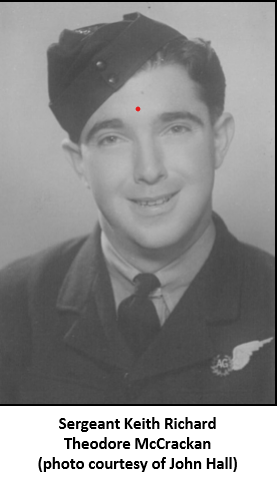
Service Number: 406219 Unit: No. 2 Squadron, R.A.A.F.
Sergeant Keith Richard Theodore McCrackan enlisted in Perth on 12th September 1940 at the age of 18. He was presumed to have been killed during a flying battle near Kema, Indonesia, on 12th January 1942 and is commemorated on the Ambon Memorial, Indonesia.
Keith McCrackan was born on 28th March 1922 in Wickepin, the son of Theodore James and Muriel McCrackan and had one brother, Keith, and three sisters, Lynette, Rona and Shirley. Keith’s father, Theo, ran the lighting plant in Wickepin and served as Secretary of the Wickepin Roads Board for many years. Keith attended primary school in Wickepin and then went to Scotch College, Perth, where he was in the cadets for two years. Keith worked as a clerk for Goldsborough Mort in Kellerberrin before enlisting. In 1943 he married Shirley Norma Hopkins, who served with the Navy in World War 2. Keith’s father Theo McCrackan served with the 28th Infantry Battalion in World War 1.
Keith McCrackan started his war service by enlisting in the Militia Forces on 21st December 1939 in Kellerberrin. He gave his birth year as 1921, therefore pretending to be over 18 years of age. He was given service number W1405 and assigned to the 25th Light Horse Regiment, where he remained until being discharged to join the R.A.A.F. in September 1940. Keith’s service record has not yet been digitised on the National Archives website and only limited information about his service can be found. The “West Australian” reports on 9th January 1941 in its “Country News”: “Air Gunner Keith McCrackan was tendered a farewell on 28th December.” It can be presumed that he was home on leave after completing his training. Keith was part of the No. 2 Squadron and the Australian War Memorial website describes the history of the unit: “No. 2 Squadron was re-formed at Laverton, Victoria, on 10th January 1937 and at the outbreak of World War 2 the unit searched for enemy vessels in Australian waters using Anson aircraft. After being re-equipped with Hudson aircraft the squadron moved to Darwin in April 1941 to perform anti-submarine activities and general reconnaissance. A detachment of four aircraft was sent to Koepang on 7th December 1941 and then to Penfoei on 11th December. The detachment provided cover to Australian troops moving within the islands and attacked Japanese shipping at Menado and Kema early the following year. A Japanese bombing raid on the Koepang base on 16th January damaged a number of planes. Further losses of aircraft, equipment, and men saw the detachment withdrawn to Darwin on 20th January 1942 and to Daly Waters on 18th February. A total of 13 crew members were lost during 1942, the squadron's most active period of operations.” Keith went missing on 12th January 1942 and is presumed to have died during a flying battle near Kema on North Sulawesi Island, Indonesia. The actions of No. 2 Squadron, alongside No. 13 Squadron, were the subject of a citation by the US War Department, as outlined in an article published in the “West Australian” on 19th January 1943: “The citation by the US War Department of two R.A.A.F. squadrons for outstanding action in the north western area is a signal distinction and in the history of the R.A.A.F. probably unique. This is the first time that two squadrons have been officially cited for their combined record of active service. The two squadrons share the distinction as they have shared everything else. Both are bomber squadrons. Both fly Hudsons. In length of service they are to all intentions and purposes equal. They were the first units of the R.A.A.F. to assault the Japanese when the war overran the islands of the Dutch archipelago. They fought in the islands together and when the islands fell they came out and together began to strike back from their new bases in Australia. And together they have continued ever since to carry the war to the Japanese. For nearly 12 months they have shouldered the main burden of the air war in the north western area, but because their exploits, though often overbrimming with danger and high courage, are seldom on a spectacular scale, all too little is publicly known of them. When Japan entered the war the two squadrons were at bases in Timor, Ambon and the island of Buru and upon them fell the first shock of the Japanese advance. There was not a crew in either squadron with experience of battle and they fought with the knowledge that the enemy was able to bring overwhelming superiority against them. So they attacked. The first attack was made by one squadron on the Japanese seaplane base at Tobi, an island on the equator. The bombs dropped by this squadron were the first blows delivered by an Australian force in the war with Japan. In the succeeding day and week the two squadrons struck continuously at Japanese ships, bases and troop concentrations, running over hundreds of miles of sea in monsoonal weather. They suffered losses in early January.” Although the two squadrons were not named in this article, the follow up article on 13th February 1943 names them as No. 2 and No. 13 Squadron of the R.A.A.F. Keith McCrackan has no known grave and is remembered on the Ambon Memorial, Indonesia, Column 10.
Sergeant Keith Richard Theodore McCrackan was 19 years of age when he died. He is honoured on the Wickepin War Memorial. There is a plaque on Marri Walk in Kings Park, Perth, dedicated by his
Fallen but not Forgotten
family. Sergeant Keith Richard Theodore McCrackan’s name is located at Panel 98 in the Commemorative Area at the Australian War Memorial.
Fallen but not Forgotten
A record of the soldiers of the Wickepin District who served their country between 1914 and 1995, with a focus on those who sacrificed their lives to shape our nation.
Researched, Written and Compiled by Stefanie Green
October 2018
Back to All News